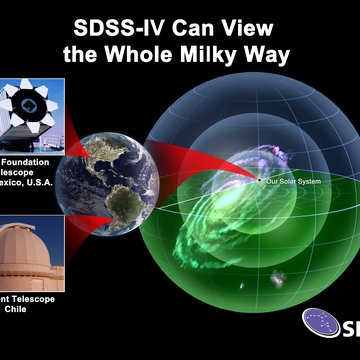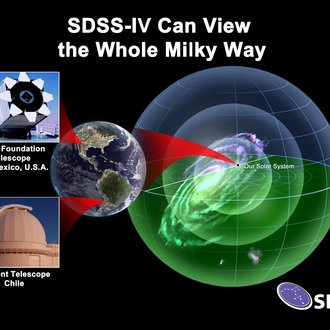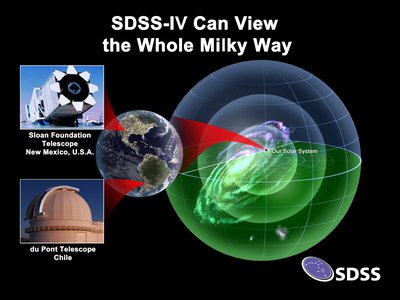The Sloan Digital Sky Survey Expands Its Reach
Building on 14 years of extraordinary discoveries, the Sloan Digital Sky Survey (SDSS) has launched a major program of three new surveys, adding novel capabilities to expand its census of the Universe into regions it had been unable to explore before.
This new phase of SDSS will explore the compositions and motions of stars across the entire Milky Way in unprecedented detail, using a telescope in Chile along with the existing Sloan Foundation Telescope.
It will make detailed maps of the internal structure of thousands of nearby galaxies to determine how they have grown and changed over billions of years, using a novel optical fiber bundle technology that can take spectra of each different part of a galaxy at once.
Sloan will measure the expansion of the Universe during a poorly understood five-billion-year period of the Universe’s history when Dark Energy started to drive its expansion, using a new set of galaxies and quasars.
The new survey is a collaboration of more than 200 astronomers at more than 40 institutions on four continents and incorporates telescopes in both the Northern and Southern Hemispheres. With these two telescopes, the SDSS will be able to see the entire sky for the first time.
Based on a press release by the SDSS collaboration
More images and videos can be found at the SDSS website.
Science contact at the AIP: Prof. Dr. Matthias Steinmetz, msteinmetz@aip.de, +49 331 7499 381
Building on 14 years of extraordinary discoveries, the Sloan Digital Sky Survey (SDSS) has launched a major program of three new surveys, adding novel capabilities to expand its census of the Universe into regions it had been unable to explore before.
This new phase of SDSS will explore the compositions and motions of stars across the entire Milky Way in unprecedented detail, using a telescope in Chile along with the existing Sloan Foundation Telescope.
It will make detailed maps of the internal structure of thousands of nearby galaxies to determine how they have grown and changed over billions of years, using a novel optical fiber bundle technology that can take spectra of each different part of a galaxy at once.
Sloan will measure the expansion of the Universe during a poorly understood five-billion-year period of the Universe’s history when Dark Energy started to drive its expansion, using a new set of galaxies and quasars.
The new survey is a collaboration of more than 200 astronomers at more than 40 institutions on four continents and incorporates telescopes in both the Northern and Southern Hemispheres. With these two telescopes, the SDSS will be able to see the entire sky for the first time.
Based on a press release by the SDSS collaboration
More images and videos can be found at the SDSS website.
Science contact at the AIP: Prof. Dr. Matthias Steinmetz, msteinmetz@aip.de, +49 331 7499 381
Images
Big screen size [1000 x 750, 100 KB]
Original size [6400 x 4800, 1.5 MB]





